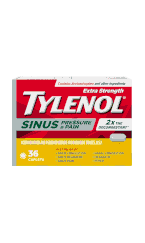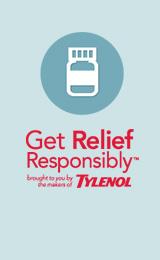Sinus Headache and Pain: Causes and Prevention
Sinus Headache and Pain: Causes and Prevention

Sinus headaches and sinus pain can be incredibly painful. They develop because of an increase in pressure in your sinuses. As a result, you may experience a runny nose, facial pain, and pain that extends into your teeth. Anything that increases the pressure in your sinuses, such as leaning forward and bending over, could make your symptoms worse.1
To minimize the risk of getting a sinus headache, it is important to take a closer look at sinus headache causes. Then, we will explore how to reduce the risk of sinus headaches and pain.
In fact, sinus headaches are not as commonly seen and are often misdiagnosed by the general population. 90% of self-diagnosed sinus headaches are actually migraines with nasal symptoms6. To understand how to differentiate a ‘true’ sinus headache and a migraine, find more information on “Is it a Sinus Headache?”.
Causes of Sinus Headaches and Pain
Sinus headaches and pain are usually due to irritation or the blockage of the sinuses. Some of the most common causes of a sinus headache include:
1. Common Cold
The common cold is the most common cause of sinus headaches. Typically, colds are caused by a virus, such as rhinovirus2. If you have a cold, you could develop congestion in your sinuses, which could increase the pressure. As the pressure goes up, you may start to feel facial pain and discomfort, leading to a sinus headache.
2. Seasonal Allergies
If you suffer from seasonal allergies, which are also called allergic rhinitis, you could develop a sinus headache. Allergic rhinitis can cause congestion to build up in the sinuses, increasing the pressure, which results in a headache.3
3. Nasal Polyps
You might also have nasal polyps. They are noncancerous growths that may form inside nasal passages and sinuses. Nasal polyps, while they might not cause congestion, take up space in your sinuses. This can increase sinus pressure, leading to a sinus headache.4
4. Deviated Septum
The nasal septum is the cartilage and bone in your nose. You may have a deviated septum when the septum is off-center. If you have a deviated septum, you could develop a sinus headache. A deviated septum encloses the space in your sinuses, causing the pressure to go up. Even if you don't have congestion, you could still develop a sinus headache.5
How to Lower the Risk of Sinus Headaches and Pain
To lower the risk of getting sinus headaches, the main goal is to reduce the chance of getting colds, keep allergies at bay and improve the immune system. There are a few tips you can follow:
1. Always wash your hands regularly, particularly during cold and flu season. If you wash your hands regularly, you can reduce your chances of getting sick, which can reduce the risk of getting congestion in your sinuses.7
2. Get your flu shot every year. If you can reduce your chances of getting the flu, you can reduce your chances of congestion building up in your sinuses. This can help you reduce the risk of getting a sinus headache.8
3. Take steps to improve your indoor air quality. You may want to replace the filters in your HVAC unit, and you might want to invest in an air purifier. If you reduce the contaminants in the air, you can reduce nasal congestion, which can reduce your chances of getting a sinus infection.
4. Drink more water. If you increase your water intake, you can keep your throat moist while also busting up any congestion you might have. This could help you reduce the risk of getting a sinus headache.9
5. Exercise regularly. If you exercise regularly, you can strengthen your immune system, reducing your chances of developing a sinus headache.10
6. Try to stay away from people who have a cold or the flu. Viruses are contagious, and if you reduce your chances of getting sick, you can reduce your chances of developing a sinus headache.7
7. Get plenty of sleep. The average adult requires between 7 and 8 hours of sleep every night. If you get enough sleep, you can strengthen your immune system.11
If you follow these tips, you may be able to reduce your risk of developing a sinus headache.
How to Relieve Sinus Pain
If you already have a sinus headache, there are steps you can take to alleviate your symptoms. A few options you may want to try include the following:
- Apply a warm compress to the face. If you apply a warm compress to your facial tissues, you could encourage your sinuses to open up a bit more, making it easier for you to alleviate congestion. Then, you can reduce the pressure in your sinuses, alleviating congestion.12
- Use a steam machine or water vaporizer. If you inhale warm water vapor into your nose, you could break up some of the congestion in your sinuses. This could help you reduce your sinus pressure, alleviating your symptoms.12
- Use TYLENOL® Sinus Pressure and Pain. This could be an effective treatment option that can help you relieve sinus congestion, headache, and pain.
These are a few possible treatment options that could help you address a sinus headache. If you want to learn more about how to alleviate a sinus headache, find more information on How to Relieve Sinus Pain.
When to See a Doctor
Ultimately, despite your best efforts, you may feel like your sinus headache is not getting any better. In that situation, a doctor may be able to help you. Some of the signs that you should consider seeing a doctor include:
- If you develop recurrent sinus headaches, you should see a doctor who can help you figure out why they keep coming back.
- If you feel like your sinus headache is getting worse despite all of the treatment options above, it may be time to see a doctor.
- If your sinus headache is causing other symptoms, such as confusion or lightheadedness, there could be something more serious going on, so you need to see a doctor.
Since sinus headaches are often confused with migraines because of the similarity in symptoms, if you are uncertain whether you have a sinus headache or migraine, you should see a doctor for a diagnosis.
Sources:
- https://www.cedars-sinai.org/health-library/diseases-and-conditions/s/sinus-headaches.html
- https://www.cdc.gov/features/rhinoviruses/index.html
- https://www.ncbi.nlm.nih.gov/pmc/articles/PMC4762930/
- https://www.hopkinsmedicine.org/health/wellness-and-prevention/could-nasal-polyps-be-the-cause-of-your-stuffy-nose
- https://my.clevelandclinic.org/health/diseases/16924-deviated-septum
- https://americanmigrainefoundation.org/resource-library/sinus-headaches/
- https://www.cdc.gov/features/rhinoviruses/index.html
- https://www.cdc.gov/flu/prevent/vaccinations.htm
- https://pubmed.ncbi.nlm.nih.gov/19145994
- https://www.ncbi.nlm.nih.gov/pmc/articles/PMC7387807/
- https://www.ncbi.nlm.nih.gov/pmc/articles/PMC5056590/
- https://www.allinahealth.org/healthysetgo/heal/ten-home-remedies-to-relieve-sinus-pain-and-pressure

GET RELIEF RESPONSIBLY®
Learn more about safe acetaminophen usage.



